Ireland

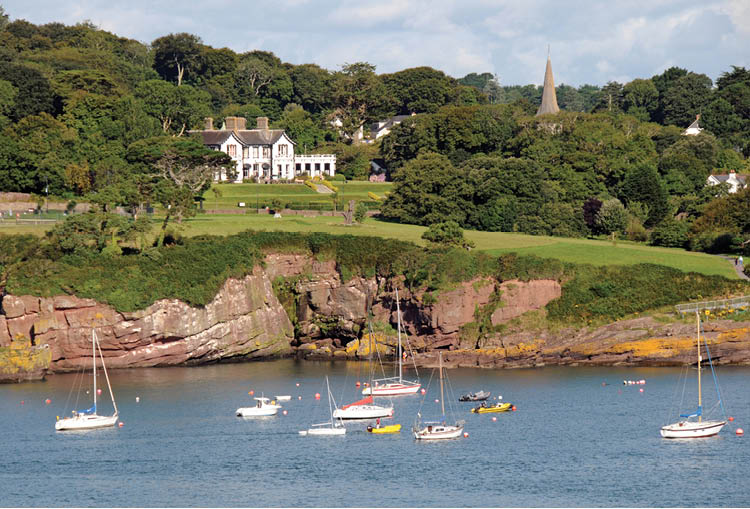
Dunmore East, near Waterford.
The green and rolling hills of Ireland are as timeless as the harp music of Turlough O’Carolan, whose travels on horseback took him from town to town performing his lyrical tunes for appreciative patrons. The winding bridle paths of the early 18th century are now narrow country roads navigable by car but still bordered by stone fences, upon which working sheepdogs regularly clamber to look around as if in search of something. It could be they just want a better view of the grazing sheep and whitewashed cottages.
The pastoral beauty of the Emerald Isle long ago inspired its early poets, whose intense love of nature created a folklore of Celtic magic and mysticism. But equally impressive to most visitors is the warm welcome of the Irish people, who must surely rank among the world’s friendliest.
Map of Ireland
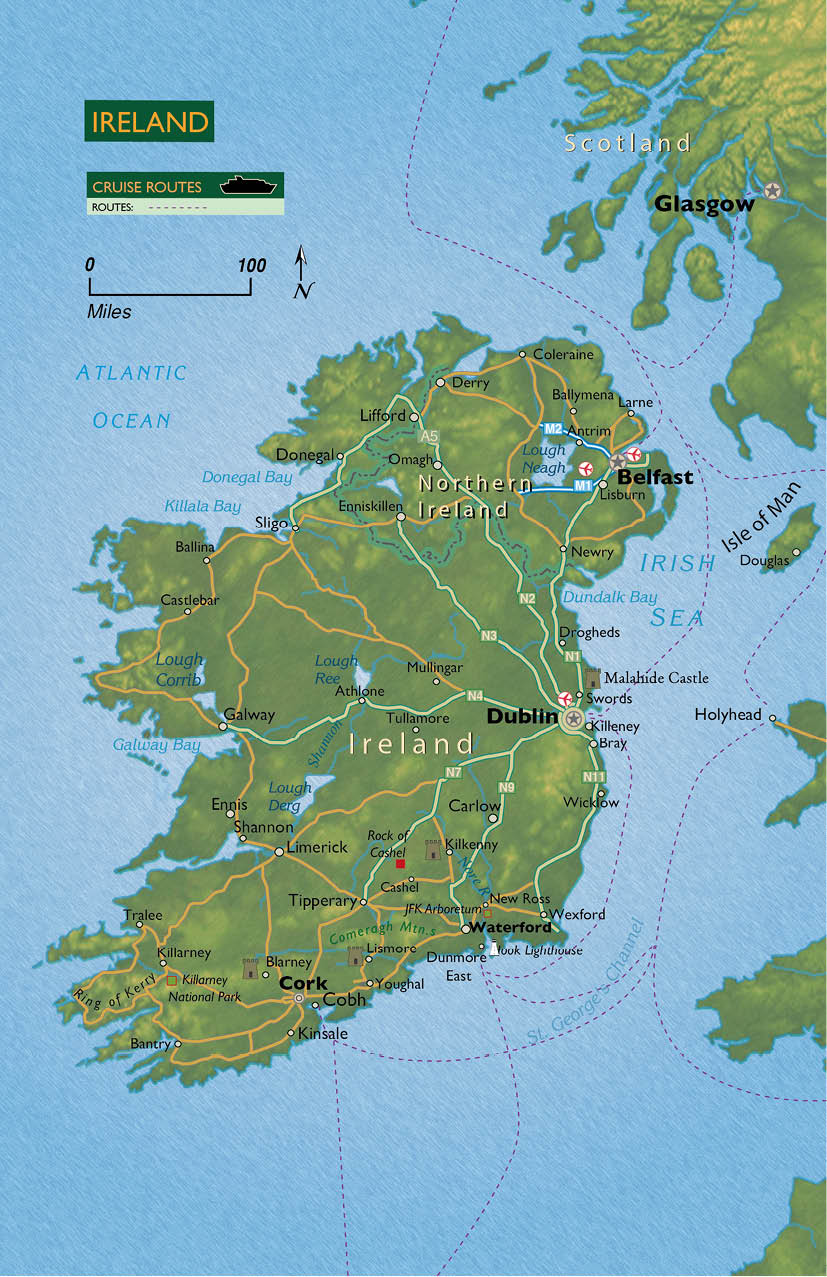
Irish hospitality harks back to the days when heroes wandered the world disguised as common men and all strangers were received graciously, for you could never be sure just who that was sitting at your table. Ancient myths and legends were preserved orally in the stories of the Druids – pagan priests who enjoyed a privileged position as official poets to the tribal chiefs. When St. Patrick introduced Christianity to Ireland in the 5th century, he too was a gifted writer who possessed an unusually winning personality.
One of the most successful missionaries in history, St. Patrick was born in Britain to affluent parents of Roman citizenship. Captured at the age of 16 by Irish marauders, he was enslaved as a herdsman for six years before escaping to continental Europe. There he entered a monastery and, following a vision that called him to return to Ireland, he spent years studying to become a missionary. A quarter of a century later, he returned to convert the Irish – tribe by tribe – until nearly all of Ireland was Christian. But pagan traditions lived on in the imagination of the Irish poets, whose verse – composed in Gaelic Irish – was admired for its melodic richness and harmonious combinations of sounds. The Irish use of rhyme was adopted into Latin and eventually spread throughout Europe as Ireland’s unique Celtic Christianity produced brilliant scholars and attracted foreign students to its monastic schools. Up until the 8th century, Ireland was a centre of learning while much of Europe was plunged into turmoil following the collapse of the Western Roman Empire.
Irish artistry thrived in medieval Ireland, including the creation of beautifully illuminated manuscripts and epic poems of romance and heroism. This golden age of Irish literature was revisited in the late 19th century when the country’s struggle for self-government inspired a cultural movement called the Irish Literary Renaissance, led by William Butler Yeats. Considered Ireland’s greatest lyric poet, Yeats was fascinated by Celtic mythology. When he accepted the Nobel Prize for Literature in 1923, he did so as “a representative of Irish literature” and his inspired poetry was described by the Nobel committee as expressing the spirit of an entire nation.

A page from the Book of Kells.
Ireland’s period of sectarian violence known as the Troubles began in the 1960s, but its seeds were sown in the 12th century when England’s King Henry II established an overlordship in Ireland, marking the start of an Anglo-Irish struggle that would last for nearly 800 years. When England imposed Protestantism on a largely Catholic Ireland in the 16th century, Irish rebellions were brutally put down by Henry VIII, Elizabeth I and Oliver Cromwell, who crushed an uprising in 1649 and confiscated Irish lands, giving these to absentee English landlords.
In 1800 Ireland was politically united with England under the Act of Union, but Irish agitation continued. Then, one of the worst natural disasters in history struck when a five-year blight ruined the country’s potato crop, the staple food of the Irish population. The Great Potato Famine lasted from 1845-49, during which time hundreds of thousands of Irish died, and 1.6 million eventually emigrated to the United States.
Irish nationalism became increasingly militant with the founding of Sinn Fein in 1905. Outlawed by the British government, Sinn Fein went underground and waged guerrilla warfare. Ireland was partitioned in 1920, its northernmost province of Ulster remaining part of the United Kingdom and thenceforth called Northern Ireland. The Irish Free State was established by treaty with Great Britain in 1922 but not fully accepted by the Irish, who wanted total independence and whose cause was pursued by the Irish Republican Army. The Republic of Ireland finally attained independence in 1949, but the troubles in Northern Ireland were far from over.

Famine memorial in Dublin
Unlike the rest of Ireland, which is overwhelmingly Irish Catholic, Ulster was populated with Scottish and English Protestant settlers who retained strong ties to Britain. Following World War II, a new generation of educated Catholics in Northern Ireland refused to accept the status quo, but hard-line Protestants refused to make concessions.
A vicious cycle of sectarian bloodletting engulfed Northern Ireland until British Prime Minister Tony Blair brokered a tentative peace deal in 1998. A power-sharing agreement between the two sides was struck in 2007, with Queen Elizabeth making a symbolic visit to Ireland in 2011. This was followed in 2014 with the first state visit to Britain in nearly a century by an Irish president. In a speech to the British Parliament, President Michael Higgens declared the two nations had attained “a closeness and warmth that once seemed unachievable.”
Meanwhile, American presidents continue to receive a warm welcome in Ireland, with Barack Obama telling a cheering crowd at Dublin’s College Green in 2011 that he had come to Ireland in search of his name’s missing apostrophe.
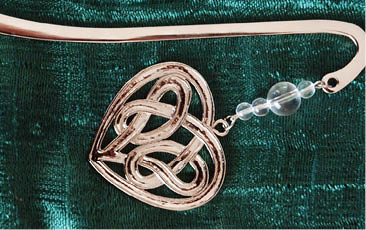
The Celtic heart knot.
Shopping items to look for in Ireland include traditional Aran sweaters made with merino wool (extremely soft and warm) in patterns reflecting the fishing culture of the Aran Islands, such as cable stitch and basket weave. Irish linens are excellent buys as are Donegal tweed sweaters and caps. Traditional Irish jewellery features the Celtic knot (symbolizing infinity) and the heart knot, which represents everlasting love when combined with the Celtic knot.

A young boy and his dog inside an Irish country pub.
The Republic of Ireland (pop. 4.6 million) occupies five-sixths of the island of Ireland, and Northern Ireland (pop. 1.8 million) occupies the remaining one-sixth. Dublin (with a half million population) is the capital of the Republic of Ireland. Belfast is the capital of Northern Ireland.
The Republic of Ireland joined the European Union in 1973 and the country’s unit of currency is the euro. The British pound is Northern Ireland’s currency.
Irish Gaelic (taught in the schools) is Ireland’s first official language, but English (the country’s second official language) is predominant throughout most of Ireland. Irish Gaelic is spoken in parts of the western seaboard and appears on road signs. Driving is on the left.
Irish pubs have long been the heart of the country’s social life and musicians often gather for a lively session over a few pints of Guinness.
Dublin began as a Viking settlement called Dubh Linn (‘dark pool’) – named for the small lake that formed where the River Poddle flowed into the River Liffey. When King John ordered construction of Dublin Castle, its moat was filled with water from the River Poddle. This tributary now flows through a brick tunnel lying beneath city streets, with Dublin Castle’s gardens lying above the site of the dark pool.
Map of Dublin
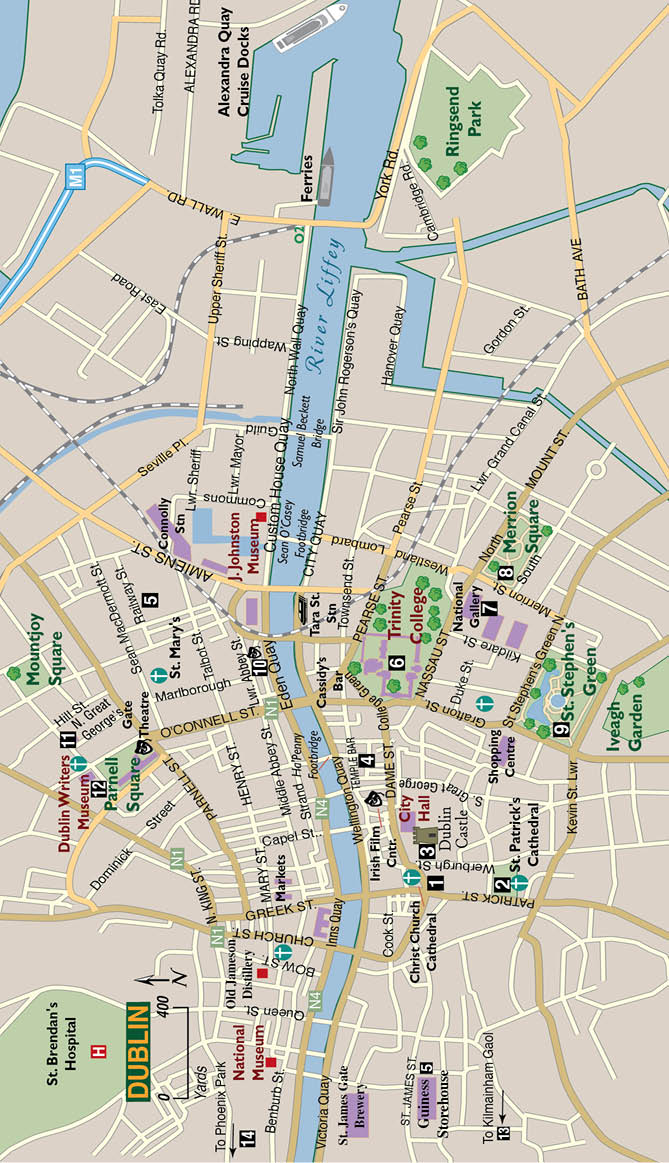
The River Liffey runs through the middle of Dublin and is spanned by numerous bridges. Large cruise ships berth at Alexandra Quay, which is about 2 miles (3.2 km) from the city centre and small ships dock along the River Liffey at North Wall Quay. Getting to town from the cruise port can be done by taxi (10 euros), your ship’s shuttle or by catching Bus #53. Hop-on Hop-Off buses operate in Dublin, starting on O’Connell Street. The port is an industrial area, but once you’re outside the gates, it’s a pleasant 45-minute walk along the River Liffy into town. Attractions along the way include an O2 amphitheatre, Samuel Beckett Bridge and Jeanie Johnston Tall Ship and Famine Museum at Custom House Quay. Dublin’s outlying suburbs include the seaside community of Killiney where Bono, The Edge, Enya and other celebrities have gated homes.

Christ Church Cathedral is Dublin’s oldest church.
The attractions in Dublin are numerous and most lie close to the River Liffey, within walking distance of one another.
1. 12th-century Christ Church Cathedral – The city’s earliest church and its rival cathedral, St. Patrick’s.
2. St. Patrick’s – which was begun in 1191 by Dublin’s first Anglo-Norman archbishop on a site near a well at which St. Patrick is said to have performed baptisms. Both cathedrals became property of the Church of Ireland during the English Reformation, and during Oliver Cromwell’s conquest of Ireland he stabled his horses in St. Patrick’s nave to show his Puritan disrespect for the Anglican religion (which was associated with Royalists). Today St. Patrick’s is Ireland’s national cathedral and Christchurch Cathedral is the seat of the Church of Ireland’s archbishop. Dublin’s Roman Catholic cathedral is St. Mary’s on Marlborough Street.
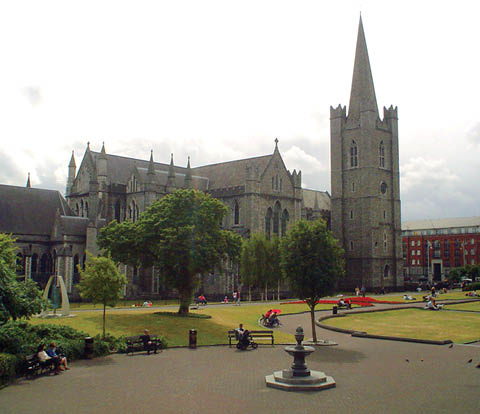
St. Patrick’s Cathedral.
3. Dublin Castle – The residence of the lord lieutenants of Ireland until 1922, after which it has housed government offices. Beside it is Dublin’s City Hall, housed in the 18th-century Royal Exchange.
4. Temple Bar area – Located near the Dublin Castle, this is the city’s cultural quarter – which is a medieval maze of cobblestoned alleys and narrow streets lined with pubs, shops and art galleries. Fishamble Street is where the first performance of Handel’s Messiah was held in 1742, and a tavern on Eustace Street is where the Society of the United Irishmen was formed at a meeting in 1791. The historic Clarence Hotel on Wellington Quay, overlooking the River Liffey, is home to the beautiful art deco Octagon Bar.

Oliver St. John Gogarty pub in Temple Bar.
Dublin is famous for its abundance of convivial pubs, many of them concentrated in the Temple Bar area, while less touristy pubs include Mulligan’s on Poolbeg Street (mentioned in one of the Dubliners stories). The Davy Byrnes (on Duke Street off Grafton) was frequented by James Joyce and is one of Dublin’s most storied pubs, as is O’Donoghue’s on Merrion Row, where the Dubliners folk band formed. Cassidy’s Bar at 27 Westmoreland (near College Green) is run by cousins of Bill Clinton, who dropped by while visiting Dublin in 1995 during his peace trip to Northern Ireland. The Bull & Castle on Christchurch Square serves good pub food, and for take-out fish and chips, try Burdock’s on Werburgh Street near Dublin Castle.
5. The Guinness Storehouse – a former fermentation plant transformed into a seven-storey visitor centre featuring a museum (tickets available online), restaurant and circular rooftop bar with views over central Dublin. Founded in 1759 by Arthur Guinness, the Guinness Brewing Company occupied dozens of grey-brick warehouses in the cobblestoned St. James’s Gate area.
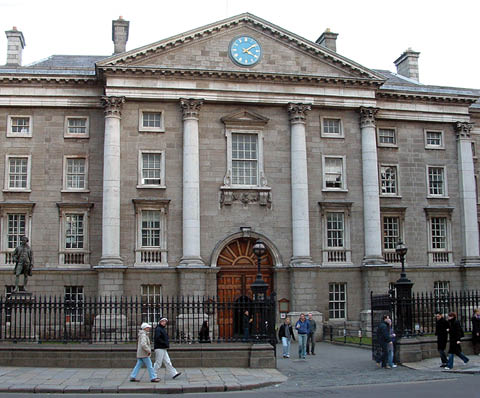
Trinity College.
6. Trinity College – Located across College Green from Temple Bar are the grounds of, founded in 1591, where the Book of Kells is on display in the library. This 8th-century manuscript of the Latin Gospels is considered the finest example of Celtic illumination. Famous Trinity alumni include Oscar Wilde, Oliver Goldsmith and Jonathan Swift, who is buried in the nave of St. Patrick’s Cathedral where he was dean from 1713 to 1745.
7. National Gallery – Located close to Trinity College are several National Museums and the National Gallery (housing a collection of old masters), which faces onto Merrion Square.
8. Merrion Square – This fine Georgian square is associated with Oscar Wilde (who lived at No. 1 Merrion Square), W. B. Yeats (who lived at No. 82) and Daniel O’Connell, Ireland’s Catholic emancipator, who lived at No. 58.
9. St. Stephen’s Green – An ancient commons which developed over time into a city park with a small lake, formal garden and bandstand. The Shelbourne Hotel opened in 1824 on the north side of St. Stephen’s Green and is where the Irish Constitution was drafted and signed in 1922. Members of Ireland’s parliament and judiciary frequent the hotel’s lounge, called the Horseshoe Bar.
Leading off the northwest corner of St. Stephen’s Green is Grafton Street – a pedestrian shopping street, busy with buskers and other street entertainers. Grafton eventually joins with Westmoreland, which leads over the O’Connell Bridge to the north side of the River Liffey. The next bridge over (to the west) is the Ha’penny Bridge – a pedestrian bridge built of cast-iron in 1816.
O’Connell Street is Dublin’s main thoroughfare, its paved central median featuring statues and monuments to various Irish political leaders. This broad boulevard has been the scene of many public celebrations and demonstrations over the years (the Post Office was seized by Irish republicans during the 1916 Easter Rising) and is the main route of the annual St. Patrick’s Day Parade. Attractions near O’Connell Street include:
10. The Abbey Theatre – Ireland’s National Theatre, founded by Yeats.
11. The James Joyce Centre – Devoted to the life and work of Joyce; housed in a Georgian townhouse on N. Great George’s Street.
12. The Dublin Writers Museum – Located at No. 18 Parnell Square.
Dublin is a literary city, its homegrown talent including the playwrights Samuel Beckett and George Bernard Shaw, and the novelist James Joyce, who spent most of his adult life abroad but whose novels are set in Dublin. Ulysses, one of the great works of world literature, recreates the events of a single June day in Dublin in 1904. This day is celebrated each June 16 as Bloomsday (for the protagonist Leopold Bloom) with Dubliners dressing up as characters in the book.
13. Kilmainham Gaol – Outlying Dublin attractions include Kilmainham Gaol, now a museum, where Irish leaders of the 1916 Easter Rising were held and executed.
14. Phoenix Park – Home to the Dublin Zoo.
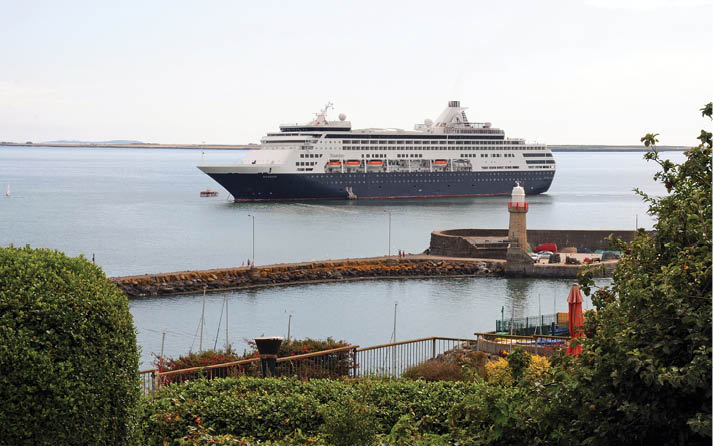
Large ships anchor at Dunmore East (Waterford’s harbour).
Founded by Vikings in 914, the coastal town of Waterford (pop. 50,000) is as scenic as it is historic. Three verdant river valleys flow into the fjord-like harbour where large cruise ships anchor and tender their passengers ashore at the seaside village of Dunmore East. The small ships proceed upriver to Waterford quay.
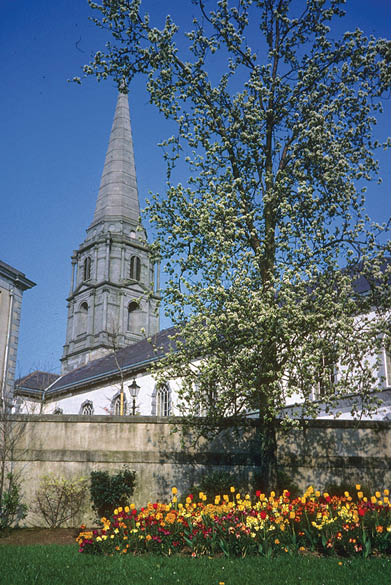
Waterford’s cathedral.
The historic village of Dunmore East, where settlement dates back to the Iron Age, is worth spending time in. Hook Head Lighthouse – a 13th-century Norman structure – marks the eastern entrance to Waterford Harbour and today houses a visitor centre, gift shop and café. The 16th-century Duncannon Fort – situated on a rocky promontory – is now home to a maritime museum, café and craft shops. There are plenty of harbourfront pubs and restaurants in Dunmore East, including The Spinnaker Bar and The Strand Inn.
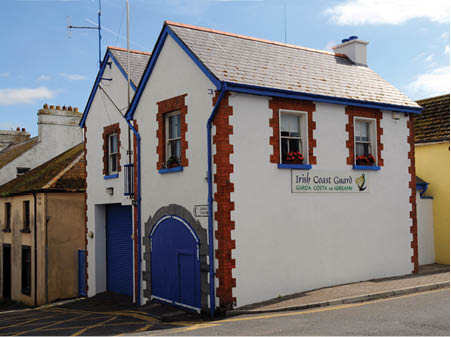
A street in Dunmore East.
Getting to Waterford from Dunmore East requires either taking a taxi, a cruise line tour or catching the Suirway bus which picks up at the Harbour House and at all bus stops on the Dunmore Road (www.suirway).
The famous crystal factory in Waterford is no longer in operation but the town remains an appealing destination with its narrow streets lined with quaint houses and shops, and its historic cathedral. It is a compact city and has been described as the Salzberg of Ireland. Nearby is a challenging golf course at Waterford Castle.
Stunning scenery around Waterford includes the Nore Valley and spectacular Vee Pass and Golden Vale in the Comeragh Mountains.
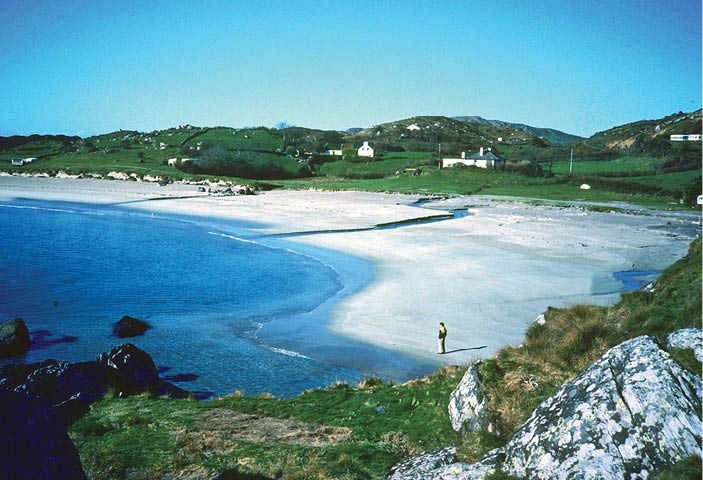
Ballycotton Bay.
Situated near the mouth of the River Lee, Cork is the major city of southern Ireland, where scenic County Cork is edged with sandy bays and seaside villages. The cruise liners dock at Cobh (meaning ‘cove’ in Irish) right beside the Heritage Centre, which offers a unique genealogy search service for people of Irish descent. Hundreds of thousands of Irish emigrants heading to America boarded ships in Cobh, which was the last port of call for RMS Titanic before it headed across the Atlantic on its doomed voyage. Cobh is about ten miles (16 km) from Cork and regular rail service connects Cobh with Cork. A train station is located just above the Heritage Centre in Cobh.
Map of Cork

Cork began as a monastic settlement founded in the 7th century by the monk Fin Barre, and was walled by the Danes in the 9th century. Much of its medieval architecture was destroyed during the guerilla warfare of the 1920s when Cork was set afire by pro-British paramilitaries. The blaze, which destroyed much of the city’s core, originated on St. Patrick’s Street, which is today part of Cork’s shopping district, as are pedestrian-only Paul Street and the covered English Market – a food market constructed in Victorian times. Cork’s most famous landmark is the 19th-century St. Fin Barre Cathedral, built of Cork limestone in the French Gothic style.
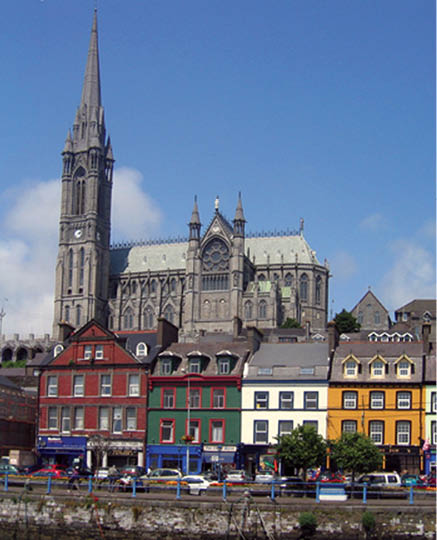
Cobh’s waterfront.
Cork’s inviting pubs include Mutton Lane Inn, located on a narrow alleyway off St. Patrick’s Street, near the English Market. Another recommended pub is The Bierhaus on Popes Quay with its selection of over 200 beers. A good restaurant choice is Bodega, housed in historic Coal Quay’s old St. Peter’s Market building on Cornmarket Street, where a Saturday Food Market is held. Suggested pubs in Cobh include the Clifton Bar on Midleton Street (just north of Cobh Cathedral) and the Rob Roy on Pearse Square.
Within easy driving distance of Cork are several major attractions, including the romantic ruins of Blarney Castle, its medieval battlements containing the famous Blarney Stone. Placed in an almost inaccessible position near the top of the castle’s thick stone walls, the Blarney Stone is said to bestow the powers of eloquence on anyone who kisses it. The village of Blarney is known for its hand-loomed tweed and is a good place to shop for Irish goods at the Blarney Woolen Mill Shop.
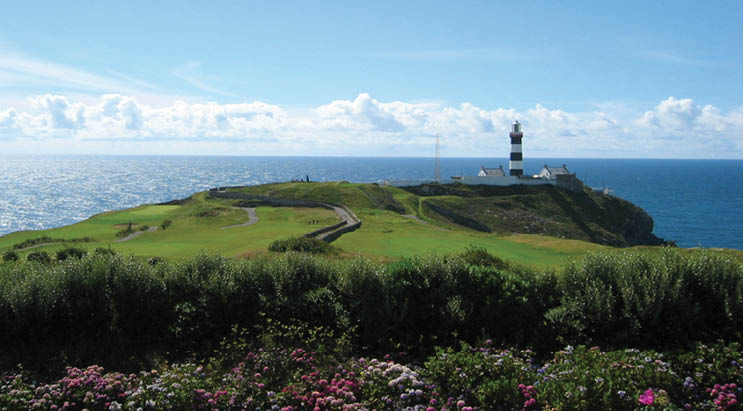
Old Head of Kinsale.
The seaside resort of Kinsale, 16 miles (25 km) south of Cork City, is a medieval harbour town of winding streets lined with gourmet restaurants and art galleries housed in 18th-century buildings. The defeat of two Irish earls by English forces at the Battle of Kinsale in 1601 brought an end to the old Gaelic aristocracy as their members were forced to abandon their lands and seek exile in Europe, their departure from Ireland called the Flight of the Earls. Another historic event associated with Kinsale is the sinking of the Lusitania in May of 1915 when a German U-boat torpedoed the Cunard liner off Old Head of Kinsale; 1,198 of the ship’s 1,959 civilian passengers perished in this wartime tragedy.
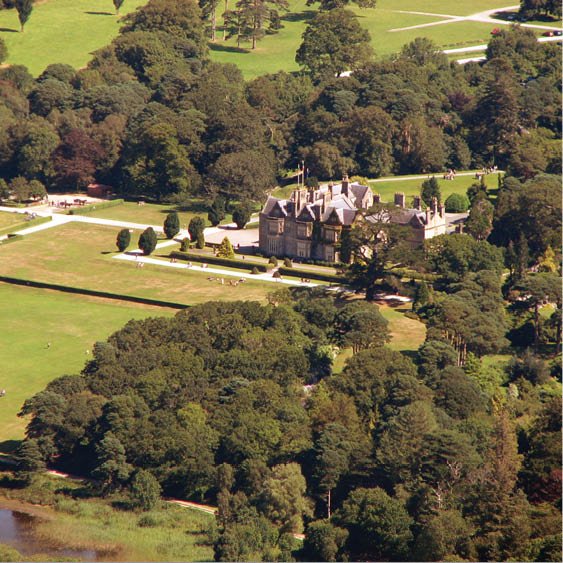
Muckross Estate
Further afield, in County Kerry, is the beautiful scenery of Killarney National Park. Originating with the 1932 donation of Muckross Estate near Killarney, this park features beautiful lakes, woodlands and mountain peaks.
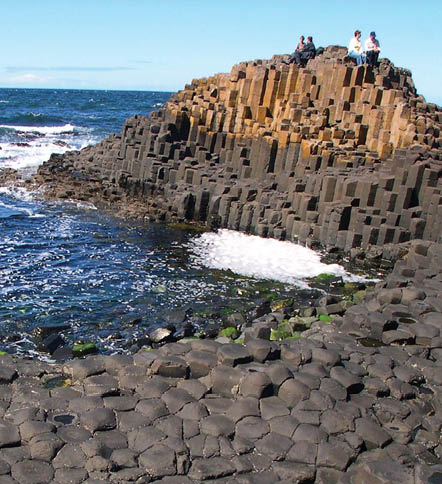
Giant’s Causeway
Now that the Troubles have ended in Northern Ireland, the capital of Belfast is rebuilding its neighbourhoods and welcoming cruise passengers to its historic harbour. Here the great shipyards of Harland and Wolff have built some of the world’s largest ocean liners, including the Titanic. In 2012, a museum commemorating this famous, ill-fated ocean liner opened on Queen’s Island. Called Titanic Belfast, the attraction consists of a massive building housing nine galleries that tell the story of the ship – from its construction, launch and maiden voyage, to its tragic sinking and eventual salvaging of the wreck.
Other Belfast landmarks include City Hall (built in the Baroque Revival style and completed in 1906) and the modern Waterfront Hall – a concert hall and exhibition centre with bars and a restaurant. The city’s cultural quarter – called Cathedral Quarter – is a former warehouse district centred on St. Anne’s Cathedral and dotted with atmospheric bars, such as The John Hewitt (a local favourite). The Crown Liquor Saloon is Belfast’s most celebrated bar with its wooden snugs and stained glass, located on Great Victoria Street. Other city attractions include the Victorian architecture of the covered St. George’s Market on May Street.
Map of Belfast
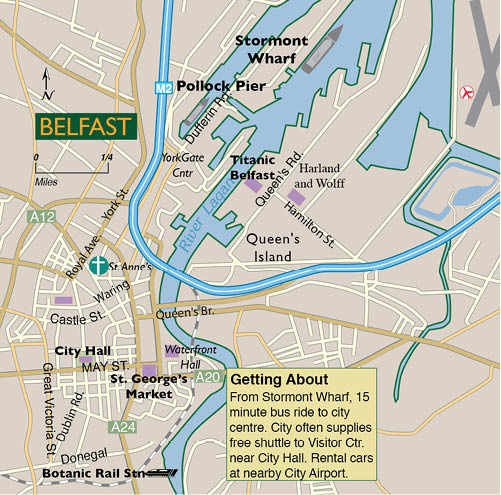
Out-of-town tours offered in Belfast include a drive north of the city to the Giant’s Causeway, where basalt columns descend from a cliff’s edge into the sea. Designated a World Heritage Site, these remarkable landforms were created by volcanic upheaval but, according to ancient legend, a giant named Finn McCool fell in love with a lady giant in Scotland and built this causeway to bring her across the channel in grand style. Other attractions in this area include Bushmills Distillery and Carrick-a-Rede Rope Bridge, a suspension bridge made of wire rope and Douglas fir, which spans a deep chasm to connect the mainland with tiny Carrick Island. The current bridge is much safer than earlier ones, yet there are still instances of visitors having to be removed by boat from the island because they can’t face walking back across the swaying bridge.
